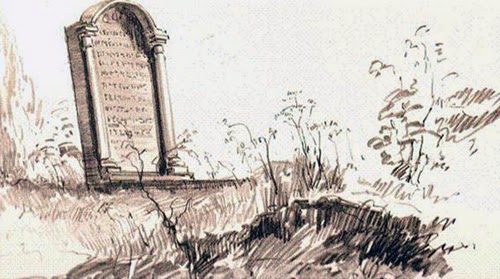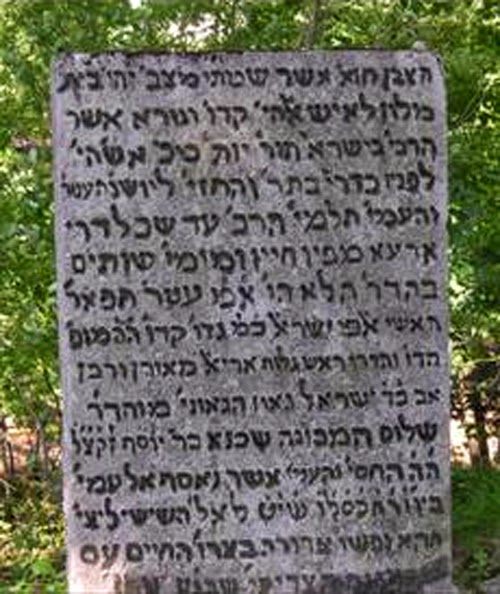Akiva Leiman: Gravely Mistaken
Gravely Mistaken
by Akiva Leiman
R. Leiman teaches high school at the Yeshiva of Greater Washington in Silver Spring, Maryland. Additionally, he leads trips to sites of Jewish interest in Eastern Europe. This is his first contribution to the Seforim blog.
One hardly need go far to find errors in published materials, but when even moderate research would suffice to unearth correct information lack of such an effort would seem egregious. Jewish burial sites have often been lost: Nazis or indigenous peoples destroyed cemeteries, acid rain ravages stones, burning candles char monuments and, of course, people just simply forget where things are.[1] Misinformation, however, would seem to be the most preventable culprit in this ever-losing battle to maintain vestiges of our heritage.
A few examples should suffice.[2]
1. In Paul Johnson’s A History of the Jews, in the very first paragraph of the actual text, he says,
There in the Cave of Machpelah, are the Tombs of the Patriarchs . . . . Across the inner courtyard is another pair of tombs, of Abraham’s grandson Jacob and his wife Leah. Just outside the building is the tomb of their[3] son Joseph.
In an endnote he references L.H. Vincent and his depiction of the cave which has been reproduced in EJ XI p. 671. There the caption does read: “Tomb of Joseph.” However, the text of the EJ explicates that, “A Muslim tradition maintains that Joseph was buried here… (t)his tradition is probably due to a corruption of the Arabic name for Esau, whose head, according to aggadic sources fell within the cave…” EJ‘s theory for the mistake aside, Johnson must not have read the text of the article (or: ignored it), for though the diagram’s caption tells us that Yosef is buried in the Cave, the text belies this point.[4] Furthermore, see Joshua 24:32 (providing Shechem as Joseph’s burial place),[5] which must, at the very least, be mentioned in any serious discussion of the final resting place for Yosef.[6]
2. In בשבילי ראדין, by M. M. Palato, Machon B’Shvilai HaYeshivot, (2001), p. 25, we are provided a picture and told “that we are being shown the final resting place of R’ Chaim of Volozhin (d. 5581 – 1821), the most esteemed student of the Vilna Gaon, and he is buried next to his mentor.”[7]
But, R’ Chaim is actually interred in Volozhin[8] and his grave is a regular stopping point for those visiting the Byelorussian town. The picture shown is of the old Ohel over the grave of the Vilna Gaon in the since-destroyed Shnipishok cemetery of Vilna. Of course, R’ Chaim’s grave is not pictured at all.[9]
3. Holy Stones: Remnants of Synagogues in Poland, drawings by Joseph Cempla, Dvir, Tel Aviv (1959) is a beautiful group of renderings of pre-war Poland. From the description for plate number 13 we read:
The gravestone of Rabbi Shalom Shachna in the Lublin Cemetery:
Rabbi Shalom ben Joseph Shachna[10] (1510-1550[11]) was one of the greatest Talmudists produced by Polish Jewry. He was the pupil of Rabbi Jacob Polak, head of the Lublin Yeshiva, who created the method of “Pilpul”[12] (casuistics)[13] employed in the study of Talmudic literature.
It is correct that R’ Shalom Shachna was a student of R’ Yaakov Polak, but the stone sketched by Cempla is not R. Shalom Shachna. Here is Cempla’s drawing:
The grave today stands without the adornments found in Cempla’s rendering: no pillars, no arch and no artistic flair filling the arch. Also, Cempla seems to indicate ten or twelve lines of etching while the current stone shows at least fifteen; puzzling, if not insurmountable issues.
A bit more research revealed the obvious error. Within twenty feet of R’ Shalom Shachne stands this prominent headstone:
This is the grave of Rabbi Yaakov Yitzchak Horowitz (d. 9 Av 5575 – 1815), the Chozeh of Lublin.[14] It seems almost certain, upon comparing Cempla’s drawing with that of the Chozeh’s headstone is that Cempla drew the Chozeh’s headstone mistaking it for the tomb of R’ Shalom Shachna which lies in its close proximity.
[1] I can recall, as a young man, visiting the old cemetery in Tzfat immediately after havdalah. I encountered a middle-aged Chassidic Jew at that strange time, and inquired after the grave of Rabbi Chaim Vital (d. 5380) the eminent student and chronicler of R’ Yitzchak Luriah – the Ari Hakadosh (d. 5332). He told me to go up the road and after a bit to ask for directions to Damascus…
[2] For another example see אבי מורי, Dr. S.Z. Leiman, in Who is Buried in the Vilna Gaon’s Tomb? Originally published in Jewish Action, Winter (1998), 59(2), and which can be found online at: http://www.ou.org/publications/ja/5759winter/leiman.htm
[3] Sic, he was the son of Rachel not Leah.
[4] See Z. Vilnai, מצבות קודש בארץ ישראל, pp. 167-176, where (p. 170) sightings of the burial place in Shechem date to 320 AD.
[5] ואת עצמות יוסף אשר העלו בני ישראל ממצרים קברו בשכם
[6] For further discussions, see L. Ginzberg, Legends of the Jews, V1, JPS (2003) p. 430 n. 443. Also, Vilnai pp. 141-144. To come full circle, in Acts 7:16 we are told that Jacob was also buried in Shechem!
[7] See note 1 above.
[8] For a nice photo, see Mishpacha, Special Supplement Succos 5767, pp. 24-25.
[9] The caption also tells us that R’ Zalmaleh of Volozhin, the brother of R’ Chaim and most brilliant student of the Vilna Gaon, is in the photo as well. He is neither in Volozhin, next to his brother, nor in the Gaon’s Ohel. See note 1. His grave has sadly been lost.
[10] I would assume that Shachna was his second, not family name; the stone reads:שלום המכונה שכנה, which would seem to be a nickname rather than a surname.
[11] See S. B. Nissenbaum’s Lekorot HaYehudim B’Lublin, p. 19 for the exact wording on his tombstone. He actually died on Friday Rosh Chodesh Kislev 5319, which was in 1558. See A. A. Akavia לוח לששת אלפי שנה p. 485.
[12] Quotes in original
[13] Parenthetic translation in original
[14]Interestingly, in Y. Alfasi החוזה מלובלין p. 107 nt. 9 there is a discussion if the Chozeh is in fact buried near R’ Shalom Shachna. He relies on a pre-war witness. Today one can go and see for himself, ואין לדיין אלא מה שעיניו רואות.



